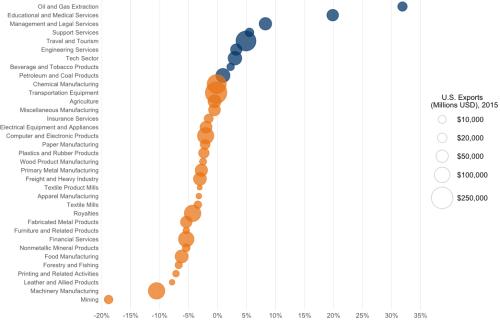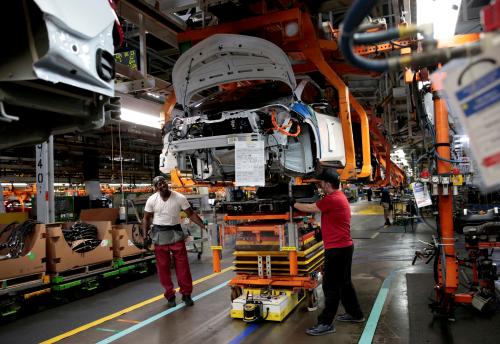In both rhetoric and action, President Trump is already drastically reshaping U.S. trade policy.
In his inaugural address, President Trump’s declaration was clear: “From this day forward, it’s going to be only America first, America first. We must protect our borders from the ravages of other countries making our product, stealing our companies and destroying our jobs. Protection will lead to great prosperity and strength.”
Moving from inaugural poetry to governing prose, the president issued an executive action on Monday of last week that withdrew the United States from the Trans-Pacific Partnership, a 12-country trade agreement that took eight years to negotiate. Following that came days that have been crowded with announcements, twitter firestorms, and diplomatic skirmishing about the new administration’s plans to perhaps impose a border tax and renegotiate NAFTA with Canada and Mexico.
Yet for all its national and global implications, an “America first” economic policy is also a matter of significant import for the nation’s local patchwork of cities, small towns, and rural areas.
Trade is generally regarded as a national issue, but it is underpinned by local collections of firms that often concentrate together to form industrial clusters. This means that changes in federal trade policy can have large implications for individual communities, whose reliance on trade can vary widely by dint of the tradability of their local industry mix and overall global orientation.
In view of this relationship, it is worth examining the geography of export reliance among U.S. metro areas. Brookings has accomplished this through its Export Monitor, which allows for a unique bottom-up look at America’s export economy, and how different parts of the country will be exposed to changes in trade policy.
What do these data show? In terms of overall volume, the nation’s major regional economies lead the way. New York, Los Angeles, Houston, Chicago, Dallas, and Seattle are trading giants, each exporting more than $50 billion annually in goods and services, and together accounting for 25 percent of national exports.

And yet large cities, while certainly global hubs of trade and commerce, are not the parts of the country most reliant on exports as a driver of economic growth and jobs. Rather, export intensity—measured as the export share of GDP—is highest in smaller energy- and manufacturing-oriented metros. At the extreme end, over half of the economy in Columbus, IN is driven by exports, largely due to its machinery manufacturing cluster. Smaller production centers in the Midwest and South also join this list, along with oil and chemical exporters in Louisiana and Texas.
Among the 100 largest metro areas, the most export-dependent economies tend to be major centers of advanced industries, reflecting U.S. advantages in aerospace (Wichita and Seattle), automotive (Detroit and Youngstown), electronics (Portland, OR and Ogden, UT), and energy (Baton Rouge, New Orleans, and Houston) production. In all of these economies, exports account for at least 15 percent of GDP and tens of thousands of jobs.


In the least trade-intensive parts of the country, exports account for less than six percent of economic output. These metro areas tend to be in the South and West, and rely more on business services and tourism and travel—two less-tradable portions of the U.S. economy.
As to what these patterns say about the nation’s trade involvement at a moment of flux, a few things jump out. For one thing, the dot map of U.S. trade reliance makes clear that while trade burns as a contentious national issue, it ultimately remains a local and regional economic activity. Trade involves millions of workers in hundreds of real and varied places, and often drives crucial local commerce. The coming trade debates will not be remote from America’s metros and communities.
At the same time, while the map shows that local trade reliance is varied, the data underscores that no clean political divide separates trade-oriented counties from others. For example, a look at the nation’s aggregate 2015 export volume shows that, while 58 percent of exports emanated from counties that voted for Hillary Clinton, fully 42 percent shipped out of counties won by Trump.

Even more strikingly, while exports made up 10 percent of the economic output in Clinton counties, the comparable figure was 13 percent for Trump counties, meaning that the latter have a special stake in the tricky matter of changing the nation’s terms of trade. That is to say, because Trump counties are on average more export-intensive than Clinton counties, they will be especially exposed to the ramifications of changes in current trade patterns.

The clear takeaway: President Trump’s campaign to remake the nation’s global trade relationships will not be a remote or academic affair—it will have real implications for regional economies. And while the benefits or disruptions of change will affect some places more than others, all of America—big-city metro and small-town or rural; red and blue; coastal or in-between—has a stake in what happens.
Export intensity rankings for all 382 metropolitan areas, download appendix table








Commentary
US metros most exposed to a Trump trade shock
January 30, 2017